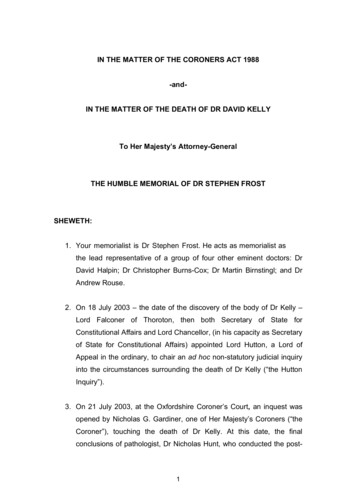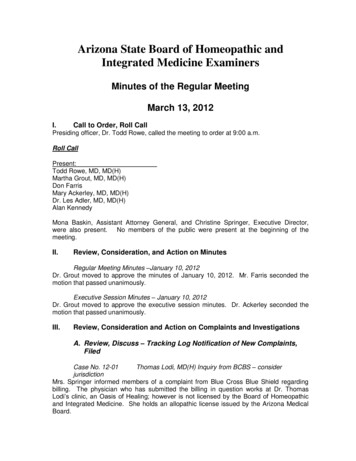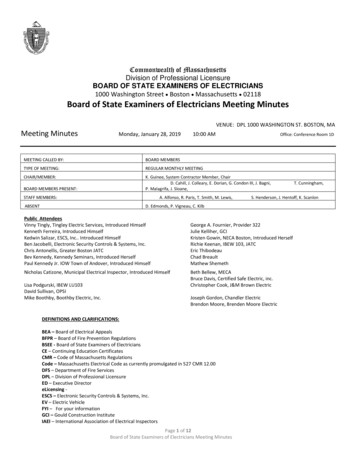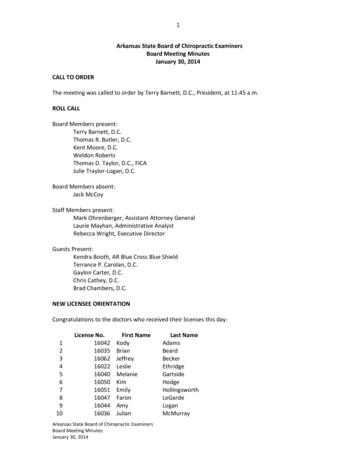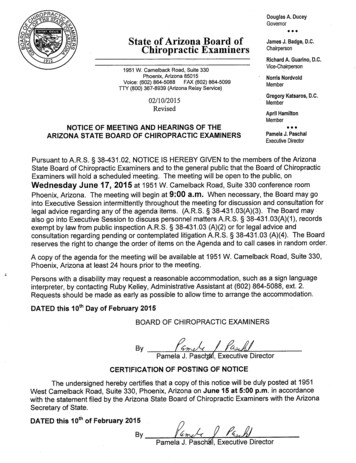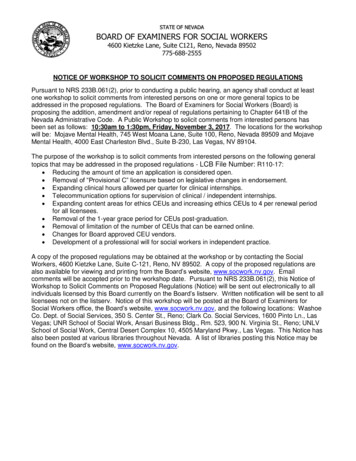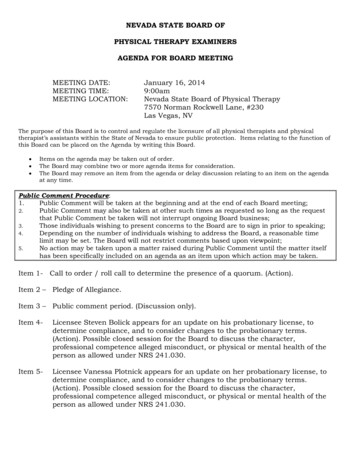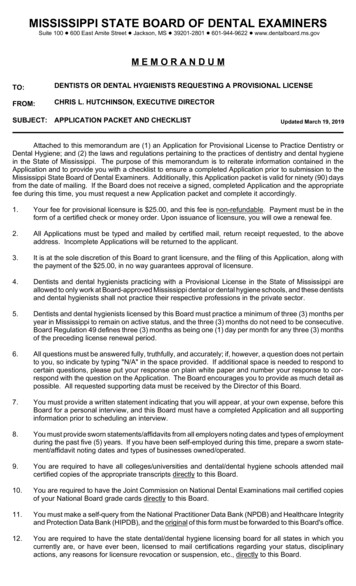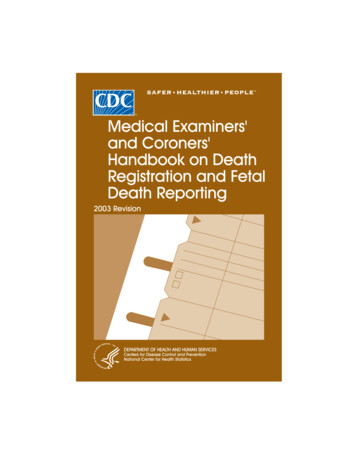
Transcription
National Center for Health StatisticsEdward J. Sondik, Ph.D., DirectorJack R. Anderson, Deputy DirectorJack R. Anderson, Acting Associate Director forInternational StatisticsJennifer H. Madans, Ph.D., Associate Director for ScienceLawrence H. Cox, Ph.D., Associate Director for Researchand MethodologyDiane M. Makuc, Dr.P.H., Acting Associate Director forAnalysis, Epidemiology, and Health PromotionP. Douglas Williams, Acting Associate Director for DataStandards, Program Development, and Extramural ProgramsEdward L. Hunter, Associate Director for Planning, Budget,and LegislationJennifer H. Madans, Ph.D., Acting Associate Director forVital and Health Statistics SystemsDouglas L. Zinn, Acting Associate Director forManagement and OperationsCharles J. Rothwell, Associate Director for InformationTechnology and ServicesDivision of Vital StatisticsJames A. Weed, Ph.D., Acting DirectorJames A. Weed, Ph.D., Acting Chief, Mortality StatisticsBranch
PrefaceThis handbook contains instructions for medical examiners and coronerson the registration of deaths and the reporting of fetal deaths. It wasprepared by the Department of Health and Human Services, Centers forDisease Control and Prevention, National Center for Health Statistics(NCHS). These instructions pertain to the 2003 revisions of the U.S. Stan dard Certificate of Death and the U.S. Standard Report of Fetal Death andthe 1992 revision of the Model State Vital Statistics Act and Regulations.This handbook is intended to serve as a model that can be adapted by anyvital statistics registration area.Other handbooks and references on preparing and registering vital recordsare mentioned at the end of the section on ‘‘Medical Certification of Death’’and are listed in the references. For most of these resources, the State vitalstatistics office or NCHS will be able to provide as many copies as requested.iii
AcknowledgmentsThis publication was prepared by staff from the Division of Vital Statisticsled by Donna L. Hoyert, Ph.D., and Arialdi M. Minino, M.P.H. Martha L.Munson, M.S., provided content for fetal death items. Robert N. Anderson,Ph.D., also contributed to this handbook. Mary Anne Freedman, M.A., theDirector of the Division of Vital Statistics while this publication was beingprepared, reviewed and commented on the contents. Expert medical review and comments were provided by Randy Hanzlick, M.D.; Gregory G.Davis, M.D.; and Lillian R. Blackmon, M.D.This handbook was edited by Kathy Sedgwick, typeset by Jacqueline M.Davis, and the graphics produced by Jarmila G. Ogburn of the Publica tions Branch, Division of Data Services.Questions about mortality and cause-of-death issues may be directed tostaff in the Mortality Statistics Branch, whereas questions about fetaldeath issues may be directed to Joyce A. Martin, M.P.H., or other staff inthe Reproductive Statistics Branch of the Division of Vital Statistics, theCenters for Disease Control and Prevention’s National Center for HealthStatistics, Hyattsville, MD 20782.v
ContentsPreface . . . . . . . . . . . . . . . . . . . . . . . . . . . . . . . . . . . . . . . . . . . . . . . . . . . . . . . . . . . . .iiiAcknowledgments . . . . . . . . . . . . . . . . . . . . . . . . . . . . . . . . . . . . . . . . . . . . . . . . . . .vIntroduction . . . . . . . . . . . . . . . . . . . . . . . . . . . . . . . . . . . . . . . . . . . . . . . . . . . . . . . .Purpose . . . . . . . . . . . . . . . . . . . . . . . . . . . . . . . . . . . . . . . . . . . . . . . . . . . . . . . . . .Importance of Death Registration and Fetal Death Reporting . . . . . . .U.S. Standard Certificates and Reports . . . . . . . . . . . . . . . . . . . . . . . . . . . .Confidentiality of Vital Records . . . . . . . . . . . . . . . . . . . . . . . . . . . . . . . . . . . .Responsibility of Medical Examiner or Coroner . . . . . . . . . . . . . . . . . . . .Death Registration . . . . . . . . . . . . . . . . . . . . . . . . . . . . . . . . . . . . . . . . . . . . .Fetal Death Reporting . . . . . . . . . . . . . . . . . . . . . . . . . . . . . . . . . . . . . . . . . .11245557General Instructions for Completing Certificates and Reports . . . . . . . .9Medical Certification of Death . . . . . . . . . . . . . . . . . . . . . . . . . . . . . . . . . . . . . .Certifying the Cause of Death . . . . . . . . . . . . . . . . . . . . . . . . . . . . . . . . . . . .Cause of Death . . . . . . . . . . . . . . . . . . . . . . . . . . . . . . . . . . . . . . . . . . . . . . . . . .Changes to Cause of Death . . . . . . . . . . . . . . . . . . . . . . . . . . . . . . . . . . . . . .Instructions . . . . . . . . . . . . . . . . . . . . . . . . . . . . . . . . . . . . . . . . . . . . . . . . . . . . .Part I of the Cause-of-death section . . . . . . . . . . . . . . . . . . . . . . . . . . . .Line (a) Immediate Cause . . . . . . . . . . . . . . . . . . . . . . . . . . . . . . . . . . .Lines (b), (c), and (d) Due to (or as a Consequence of) . . . . . . . .Approximate Interval Between Onset and Death . . . . . . . . . . . . .Part II of the Cause-of-Death section (Other SignificantConditions) . . . . . . . . . . . . . . . . . . . . . . . . . . . . . . . . . . . . . . . . . . . . . . . . . .Other Items for Medical Certification . . . . . . . . . . . . . . . . . . . . . . . . . . . . .Autopsy . . . . . . . . . . . . . . . . . . . . . . . . . . . . . . . . . . . . . . . . . . . . . . . . . . . . . . .Circumstances of Injury or Violence . . . . . . . . . . . . . . . . . . . . . . . . . . .Special Problems for the Medical-Legal Officer . . . . . . . . . . . . . . . . . . . .Precision of Knowledge Required to Complete Death CertificateItems . . . . . . . . . . . . . . . . . . . . . . . . . . . . . . . . . . . . . . . . . . . . . . . . . . . . . . . .Trauma as a Cause of Death . . . . . . . . . . . . . . . . . . . . . . . . . . . . . . . . . .Natural . . . . . . . . . . . . . . . . . . . . . . . . . . . . . . . . . . . . . . . . . . . . . . . . . . . . .Accident . . . . . . . . . . . . . . . . . . . . . . . . . . . . . . . . . . . . . . . . . . . . . . . . . . . .Suicide . . . . . . . . . . . . . . . . . . . . . . . . . . . . . . . . . . . . . . . . . . . . . . . . . . . . .Homicide . . . . . . . . . . . . . . . . . . . . . . . . . . . . . . . . . . . . . . . . . . . . . . . . . . .1111111414151516161718181920202021212121vii
Could not be Determined . . . . . . . . . . . . . . . . . . . . . . . . . . . . . . . . . . .Pending Investigation . . . . . . . . . . . . . . . . . . . . . . . . . . . . . . . . . . . . . . .Determining a Suicide . . . . . . . . . . . . . . . . . . . . . . . . . . . . . . . . . . . . . . . . .When Cause Cannot be Determined . . . . . . . . . . . . . . . . . . . . . . . . . . .Deferred ‘‘Pending Investigation’’ . . . . . . . . . . . . . . . . . . . . . . . . . . . . . . .Certifier Section . . . . . . . . . . . . . . . . . . . . . . . . . . . . . . . . . . . . . . . . . . . . . . . . .Examples of Medical Certification . . . . . . . . . . . . . . . . . . . . . . . . . . . . . . . .Common Problems in Death Certification . . . . . . . . . . . . . . . . . . . . . . . .Additional Resources . . . . . . . . . . . . . . . . . . . . . . . . . . . . . . . . . . . . . . . . . . . .212121222224254042Completing Other Items on the Death Certificate . . . . . . . . . . . . . . . . . . .About the Decedent (Items 1–19, 51–55) . . . . . . . . . . . . . . . . . . . . . . . . .Parents (Items 11 and 12) . . . . . . . . . . . . . . . . . . . . . . . . . . . . . . . . . . . . . . .Informant (Items 13a–c) . . . . . . . . . . . . . . . . . . . . . . . . . . . . . . . . . . . . . . . . .Place of Death (Items 14) . . . . . . . . . . . . . . . . . . . . . . . . . . . . . . . . . . . . . . . .Facility (Items 15–17) . . . . . . . . . . . . . . . . . . . . . . . . . . . . . . . . . . . . . . . . . . . .About the Disposition (Items 18–23) . . . . . . . . . . . . . . . . . . . . . . . . . . . . . .Pronouncement (Items 24 and 25) . . . . . . . . . . . . . . . . . . . . . . . . . . . . . . .Pronouncing Physician (Items 26–28) . . . . . . . . . . . . . . . . . . . . . . . . . . . .Date of Death (Item 29) . . . . . . . . . . . . . . . . . . . . . . . . . . . . . . . . . . . . . . . . . .Time of Death (Item 30) . . . . . . . . . . . . . . . . . . . . . . . . . . . . . . . . . . . . . . . . . .Medical Examiner or Coroner Contacted (Item 31) . . . . . . . . . . . . . . . .Cause of Death (Item 32) . . . . . . . . . . . . . . . . . . . . . . . . . . . . . . . . . . . . . . . .Autopsy (Items 33 and 34) . . . . . . . . . . . . . . . . . . . . . . . . . . . . . . . . . . . . . . .Tobacco Use Contribute to Death (Item 35) . . . . . . . . . . . . . . . . . . . . . . .If Female, Pregnancy Status (Item 36) . . . . . . . . . . . . . . . . . . . . . . . . . . . .Manner of Death (Item 37) . . . . . . . . . . . . . . . . . . . . . . . . . . . . . . . . . . . . . . .Accident or Injury (Items 38–44) . . . . . . . . . . . . . . . . . . . . . . . . . . . . . . . . .Certifier (Items 45–49) . . . . . . . . . . . . . . . . . . . . . . . . . . . . . . . . . . . . . . . . . . .Decedent’s Education (Item 51) . . . . . . . . . . . . . . . . . . . . . . . . . . . . . . . . . .Decedent of Hispanic Origin (Item 52) . . . . . . . . . . . . . . . . . . . . . . . . . . . .Race (Item 53) . . . . . . . . . . . . . . . . . . . . . . . . . . . . . . . . . . . . . . . . . . . . . . . . . . .Occupation and Industry of Decedent (Items 54 and 55) . . . . . . . . . pleting the Cause of Fetal Death . . . . . . . . . . . . . . . . . . . . . . . . . . . . . . .Cause of Fetal Death . . . . . . . . . . . . . . . . . . . . . . . . . . . . . . . . . . . . . . . . . . . .Supplemental Report of Cause of Fetal Death . . . . . . . . . . . . . . . . . . . .Other Items for Medical Certification . . . . . . . . . . . . . . . . . . . . . . . . . . . . .Examples of Reporting Cause of Fetal Death . . . . . . . . . . . . . . . . . . . . .Common Problems in Fetal Death Certification . . . . . . . . . . . . . . . . . . .747477777881Completing the Report of Fetal Death . . . . . . . . . . . . . . . . . . . . . . . . . . . . . . 83FACILITY WORKSHEET . . . . . . . . . . . . . . . . . . . . . . . . . . . . . . . . . . . . . . . . . 83CAUSE OF FETAL DEATH . . . . . . . . . . . . . . . . . . . . . . . . . . . . . . . . . . . . . 95PATIENT WORKSHEET . . . . . . . . . . . . . . . . . . . . . . . . . . . . . . . . . . . . . . . . . . 98viii
References . . . . . . . . . . . . . . . . . . . . . . . . . . . . . . . . . . . . . . . . . . . . . . . . . . . . . . .105AppendixesA.B.C.D.E.F.G.H.The U.S. Standard Certificate of Death . . . . . . . . . . . . . . . . . . . . . . .Decedent’s Educational Level Selection Card . . . . . . . . . . . . . . . . .Race and Hispanic Origin Category Selection Cards . . . . . . . . . .The U.S. Standard Report of Fetal Death . . . . . . . . . . . . . . . . . . . . .Definitions of Live Birth and Fetal Death . . . . . . . . . . . . . . . . . . . . .Facility Worksheet for the Report of Fetal Death . . . . . . . . . . . . . .Patient’s Worksheet for the Report of Fetal Death . . . . . . . . . . . . .The Vital Statistics Registration System in the United States . .108110111112114115123128ix
IntroductionPurposeThis handbook is designed to acquaint medical examiners and coronerswith the vital registration system in the United States and to provideinstructions for completing and filing death certificates and fetal deathreports. Emphasis is directed toward the certification of medical informa tion relating to these events when they come within the jurisdiction of themedical-legal officer (i.e., medical examiner or coroner).A significant number of the deaths occurring in the United States must beinvestigated and certified by a medical-legal officer. Although State lawsvary in specific requirements, deaths that typically require investigationare those due to unusual or suspicious circumstances, violence (accident,suicide, or homicide), those due to natural disease processes when thedeath occurred suddenly and without warning, when the decedent was notbeing treated by a physician, or the death was unattended (1).In those cases where death is not the result of accident, suicide, or homi cide, some States include in their laws a specific time period regarding howrecently treatment must have been provided by a physician for that phy sician to be authorized to complete the medical certification of cause ofdeath. These time limits vary from State to State. In some States where notime limit is specified, it is left to interpretation or local custom to determine whether the cause of death should be completed by a physician or bythe medical examiner or coroner. The medical-legal officer should investi gate the case and ensure that the medical certification of cause of death isproperly completed.Because State laws, regulations, and customs vary significantly regardingwhich cases must be investigated by a medical-legal officer, each medicalexaminer or coroner must become familiar with practices within the offic er’s area and ensure that all cases falling within his or her jurisdiction areproperly investigated. If there is any doubt as to jurisdiction, the medicallegal officer should assume jurisdiction.1
Importance of death registration and fetal death reportingThe death certificate is a permanent record of the fact of death, anddepending on the State of death, may be needed to get a burial permit. Theinformation in the record is considered as prima facie evidence of the factof death that can be introduced in court as evidence. State law specifiesthe required time for completing and filing the death certificate.The death certificate provides important personal information about thedecedent and about the circumstances and cause of death. This informa tion has many uses related to the settlement of the estate and providesfamily members’ closure, peace of mind, and documentation of the causeof death.The death certificate is the source for State and national mortality statis tics (figures 1–3) and is used to determine which medical conditions re ceive research and development funding, to set public health goals, and tomeasure health status at local, State, national, and international levels.The Centers for Disease Control and Prevention’s National Center forHealth Statistics (NCHS) publishes summary mortality data in the Na tional Vital Statistics Report publication ‘‘Deaths: Final data’’ and on theInternet at http://www.cdc.gov/nchs (under vital statistics, mortality).These mortality data are valuable to physicians indirectly by influencingfunding that supports medical and health research (which may alter clini cal practice) and directly as a research tool. Research topics include iden tifying disease etiology, evaluating diagnostic and therapeutic techniques,examining medical or mental health problems that may be found amongspecific groups of people (2), and indicating areas in which medical research can have the greatest impact on reducing mortality.Analyses typically focus on a single condition reported on the death cer tificate, but some analyses do consider all conditions mentioned. Suchanalyses are important in studying certain diseases and conditions and ininvestigating relationships between conditions reported on the same deathcertificate (for example, types of fatal injuries and automobile crashes ortypes of infections and HIV).Because statistical data derived from death certificates can be no moreaccurate than the information provided on the certificate, it is very impor tant that all persons concerned with the registration of deaths strive notonly for complete registration, but also for accuracy and promptness inreporting these events. Furthermore, the potential usefulness of detailedspecific information is greater than more general information.2
Figure 1. Deaths by ageFigure 2. Deaths by cause3
Figure 3. Percent of persons born alive in selected yearssurviving to specific agesThe fetal death report is recommended as a legally required statisticalreport designed primarily to collect information for statistical and researchpurposes. In most States, these reports are not maintained in the officialfiles of the State health department, and certified copies of these reportsare rarely issued. However, in a number of States, it remains a legalcertificate. The record, whether a certificate or a report, provides valuablehealth and research data. The information is used to study the causes ofpoor pregnancy outcome. These data are also essential in planning andevaluating prenatal care services and obstetrical programs. They are alsoused to examine the consequences of possible environmental and occupational exposures of parents on the fetus.U.S. Standard Certificates and ReportsThe registration of deaths and fetal deaths is a State function supported byindividual State laws and regulations. The original certificates are filed inthe States and stored in accordance with State practice. Each State has acontract with NCHS that allows the Federal Government to use information from the State records to produce national vital statistics. The national data program is called the National Vital Statistics System (NVSS)(3,4).4
To ensure consistency in the NVSS, NCHS provides leadership and coordination in the development of a standard certificate of death for the Statesto use as a model. The standard certificate is revised periodically to ensurethat the data collected relate to current and anticipated needs. In therevision process, stakeholders review and evaluate each item on the standard certificate for its registration, legal, genealogical, statistical, medical,and research value. The associations on the stakeholder panel that recommended the current U.S. Standard Certificate of Death included the American Medical Association, the National Association of Medical Examiners,the College of American Pathologists, and the American Hospital Association (3). For the U.S. Standard Report of Fetal Death, the associationsincluded the American Academy of Pediatrics, American College of Obstetricians and Gynecologists, Association of State and Territorial HealthOfficers (Maternal and Child Health Affiliate), American Medical Association, and American College of Nurse Midwives (3).Most State certificates conform closely in content and arrangement to thestandard. Minor modifications are sometimes necessary to comply withState laws or regulations or to meet specific information needs. Havingsimilar forms promotes uniformity of data and comparable national statistics. They also allow the comparison of individual State data with nationaldata and data from other States. Uniformity of death certificates amongthe States also increases their acceptability as legal records.Confidentiality of vital recordsTo encourage appropriate access to vital records, NCHS promotes thedevelopment of model vital statistics laws concerning confidentiality (1).State laws and supporting regulations define which persons have authorized access to vital records. Some States have few restrictions on accessto death certificates. However, there are restrictions on access to deathcertificates in the majority of States. Legal safeguards to the confidentialityof vital records have been strengthened over time in some States.The fetal death report is designed primarily to collect information forstatistical and research purposes. In many States these records are notmaintained in the official files of the State health department. Most Statesnever issue certified copies of these records; the other States issue certifiedcopies very rarely.Responsibility of the medical examiner or coronerDeath registrationThe principal responsibility of the medical examiner or coroner in deathregistration is to complete the medical part of the death certificate. Before5
delivering the death certificate to the funeral director, he or she may addsome personal items for proper identification such as name, residence,race, and sex. Under certain circumstances and in some jurisdictions, heor she may provide all the information, medical and personal, required onthe certificate.The funeral director, or other person in charge of interment, will otherwisecomplete those parts of the death certificate that call for personal information about the decedent. He or she is also responsible for filing the certificate with the registrar where the death occurred. Each State prescribesthe time within which the death certificate must be filed with the registrar.In general, the duties of the medical examiner or coroner are to: Complete relevant portions of the death certificate. Deliver the signed or electronically authenticated death certificate tothe funeral director promptly so that the funeral director can file it withthe State or local registrar within the State’s prescribed time period. Assist the State or local registrar by answering inquiries promptly. Deliver a supplemental report of cause of death to the State vitalstatistics office when autopsy findings or further investigation revealsthe cause of death to be different from what was originally reported.When the cause of death cannot be determined within the statutory timelimit, a death certificate should be filed with the notation that the report ofcause of death is ‘‘deferred pending further investigation.’’ A permit toauthorize disposal or removal of the body may then be obtained.If there are other reasons for a delay in completing the medical portion ofthe certificate, the registrar should be given written notice of the reason forthe delay.When the circumstances of death (accident, suicide, or homicide) cannotbe determined within the statutory time limit, the cause-of-death sectionshould be completed and the manner of death should be shown as ‘‘pending investigation.’’As soon as the cause of death and circumstances or manner of death aredetermined, the medical examiner or coroner should file a supplementalreport with the registrar or correct or amend the death certificate according to State and local regulations regarding this procedure.6
When a body has been found after a long period of time, the medicalexaminer or coroner should estimate the date and time of death as accurately as possible. If an estimate is made, the information should beentered as ‘‘APPROX—date’’ and/or ‘‘APPROX—time.’’If completed properly, the cause of death will communicate the sameessential information that a case history would (5). For example, thefollowing cause-of-death statement is complete:I a) Septic shockb) Infected decubitus ulcersc) Complications of cerebral infarctiond) Cerebral artery atherosclerosisII Insulin-dependent diabetes mellitusIf not completed properly, information may be missing from the cause-ofdeath section, so someone reading the cause of death would not know whythe condition on the lowest used line developed. For example:I a) Pneumoniab) MalnutritionIIThis example does not explain what caused malnutrition. A variety ofdifferent circumstances could cause malnutrition, so the statement isincomplete and ambiguous.In some cases, the medical-legal officer will be contacted to verify information reported on a death certificate or to provide additional information toclarify what was meant. The original cause-of-death statement may not bewrong from a clinical standpoint, but may not include sufficient information for assigning codes for statistical purposes. Following guidelines inthis handbook should minimize the frequency with which the medicalexaminer or coroner will need to spend additional time answering follow-upquestions about a patient’s cause of death.Fetal death reportingIn some jurisdictions the medical-legal officer is required to completereports of fetal death when the fetal death occurred without medical attendance or occurred under strange or unusual circumstances or was aresult of an accident, suicide, or homicide. When completing a report offetal death, the medical examiner or coroner is to: Complete the cause-of-fetal-death section.7
Return the fetal death report to the person or institution charged byState law with the responsibility for filing the report. If the medical-legal officer is required by State law to fill out a report offetal death when the fetal death occurs outside a hospital or otherinstitution, complete such a report and send it directly to the local orState registrar.When an abandoned infant or apparent newborn is found dead, a problemmay arise as to whether the event should be registered as a fetal death oran infant death (see appendix E for definitions). If the infant is consideredto have lived, even for a very short time, following delivery, then themedical examiner or coroner will use the death certificate usually employed. He or she must also ensure that the birth of this infant is properlyregistered. If the infant is considered to be a fetal death or stillborn, thenthe appropriate fetal death report must be completed.8
General Instructions for Completing Certificates andReportsAside from the facts related to medical certification, the medical examineror coroner may need to obtain some or all of the personal informationrequired on the certificate or report.In some jurisdictions the medical-legal officer is not required to completeall of the personal items. He or she may complete and sign the medicalcertification section and add a few identifying items, such as name, age,sex, race, and residence. The certificate or report is then given to thefuneral director who completes the remainder of the record.In other jurisdictions the medical-legal officer customarily completes allthe personal items. Under such conditions the medical examiner or coroner must obtain the information from an informant who has knowledge ofthe facts.The informant is usually a member of the family or a friend of the family.The following individuals can be the informant and are listed in order ofpreference: spouse, a parent, a child of the decedent, another relative, orother person who has knowledge of the facts. At times the medical examiner or coroner will have to obtain personal information from a physicianor a hospital official. In some cases, information will be obtained from thepolice.Whatever the source may be, the name, relationship to decedent, andmailing address of the informant must appear on the certificate in thespace provided.It is essential that certificates and reports be prepared as permanentdurable records. Completing a death certificate involves the following guidelines: Use the current form designated by the State. Complete each item, following the specific instructions for that item. Take care to make entry legible. Use a computer printer with highresolution, typewriter with good black ribbon and clean keys, or printlegibly using permanent black ink.9
Do not use abbreviations except those recommended in the specificitem instructions. Verify with the informant the spelling of names, especially those thathave different spellings for the same sound (Smith or Smyth, Gail orGayle, Wolf or Wolfe, and so forth). Refer problems not covered in these instructions to the State office ofvital statistics or to the local registrar. Obtain all signatures; rubber stamps or other facsimile signatures arenot acceptable. If jurisdiction provides, authenticate electronically. Do not make alterations or erasures. File the original certificate or report with the registrar. Reproductionsor duplicates are not acceptable. File a supplemental report after investigation is completed for recordspreviously filed as ‘‘pending further investigation.’’10
Medical Certification of DeathCertifying the cause of deathThe medical examiner or coroner’s primary responsibility in death registration is to complete the medical part of the death certificate. The medicalcertification includes: Date and time pronounced dead; Date and time of death; Question on whether the case was referred to the medical examiner orcoroner; Cause-of-death section including cause of death, manner of death,tobacco use, and pregnancy status items; Injury items for cases involving injuries; Certifier section with signatures.The proper completion of this section of the certificate is of utmost importance to the efficient working of a medical-legal investigative system.Cause of deathThis section must be completed by the medical examiner or coroner. Thecause-of-death section, a facsimile of which is shown on page 12, followsguidelines recommended by the World Health Organization. An importantfeature is the reported underlying cause of death determined by the medical examiner or coroner and defined as (a) the disease or injury thatinitiated the train of morbid events leading directly to death, or (b) thecircumstances of the accident or violence that produced the fatal injury. Inaddition to the underlying cause of death, this section provides for reporting the entire sequence of events leading to death as well as other conditions significantly contributing to death (6).The cause-of-death section is designed to elicit the opinion of the medicalcertifier. Causes of death on the death certificate represent a medicalopinion that might vary among individual medical-legal officers. A properly11
completed cause-of-death section provides an etiological explanation ofthe order, type, and association of events resulting in death. The initialcondition that starts the etiological sequence is specific if it does not leaveany doubt as to why it developed. For instance, sepsis is not specificbecause a number of different conditions may have resulted in sepsis,whereas Human immunodeficiency virus infection is specific.In certifying the cause of death, any disease, abnormality, injury, or poisoning, if believed to have adversely affected the de
Preface This handbook contains instructions for medical examiners and coroners on the
